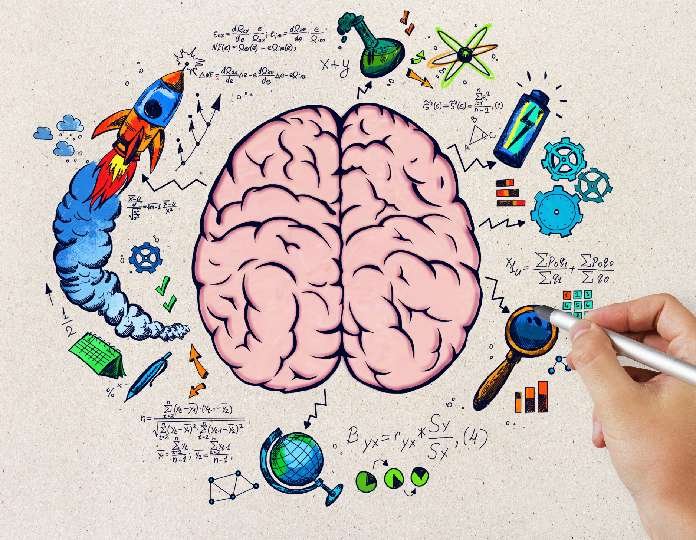An average human being spends one-third of their day sleeping as sleep is the most important part of daily routine, just like eating food or drinking water. Sleep provides energy to keep going throughout the day; good quality sleep means sleeping 7-8 hours daily. Sleep plays a crucial role in removing toxins from the brain that accumulate throughout the day. Also, sleep is important for various brain functions like communication between nerve cells, since the brain and body remain active even when the person is sleeping. In this article, we will explore the intricacies of sleep and its impact on mental health with insights into the neurobiology of sleep, including brain function, sleep stages, and their significance in promoting well-being.
Different structure within the brain that helps with the production and maintenance of sleep
1) Hypothalamus:
The Hypothalamus which is a small pea-like Structure is located deep within the brain and is a part of the forebrain. It contains various control centers, like a group of nerve cells that affect sleep and arousal. The suprachiasmatic nucleus (SCN) is a cluster of thousands of cells located within the hypothalamus that receives from the eyes, the information about the light exposure it gets and so accordingly controls the behavior rhythms.
Also Read: Irritable Bowel Syndrome and Mental Health’s Impact on Well-being
2) Damage to SCN:
If damage occurs to the suprachiasmatic nucleus (SCN), individuals may experience significant daytime sleepiness. The reason behind this is the person’s inability to match circadian rhythms to the light and dark cycle.
3) Brain stem:
The brain stem, formed by the combination of the midbrain and the hind Brain (pons and medulla) and is located at the base, controls the transition between sleep and wake by communicating with hypothalamus.

Brain stem plays a crucial role in REM sleep. Also, we often wonder how we’re still on the bed or couch while sleeping and don’t act out in dreams, even though the brain is active. This is because the brain stem sends relaxed signals to the muscles responsible for limb movements and body posture.
3) Gamma Amino Butyric Acid or GABA:
Sleep-producing cells in the hypothalamus and brain stem produce the brain chemical GABA, which decreases activity in the arousal center of the hypothalamus and brain stem.
4) Thalamus:
The thalamus passes the integrated information from the senses to the cerebral cortex. Most of the time, the thalamus is quiet enough to keep the individual away from the external world by tuning out. However, during the REM stage of sleep, the thalamus gets active and sends the cortex, the images, sounds, and other stimuli to fill the contents of the dreams.
Also Read: Healing Through Art: The Power of Creative Expression
5) Pineal gland:
The pineal gland situated within the right and left brain’s hemispheres increases the production of melatonin by receiving signals from the suprachiasmatic nucleus. Melatonin is a hormone that maintains the sleep-wake cycle by helping the person sleep as soon as the lights go down. The peaks and valleys of melatonin help in matching the light and dark cycle with the body’s circadian rhythms.
6) Basal forebrain:
The basal forebrain also promotes sleep and wakefulness. Caffeine consumption blocks the actions of adenosine, the release of which supports the sleep drive. That is the reason why after drinking coffee a person is not able to sleep and people often use caffeine to keep themselves awake.
7) Amygdala:
The amygdala is an almond-shaped structure that is a part of the limbic system whose main function is to regulate and process emotions. However, it gets Increasingly active during REM sleep.
Also Read: Understanding Psychology Behind Fear and Phobias
Stages of sleep
There are four stages of sleep and each one has its own unique functions and roles in maintaining the brain’s cognitive tasks. The first three stages of sleep, known as NREM sleep (non-rapid eye movement sleep) or quiet sleep, and the fourth stage, REM sleep (rapid eye movement) or active sleep, constitute the four stages of sleep.
The stages of sleep along with physical repairs, keep the individual healthy and are responsible for making the person active to carry out activities each passing day.
NREM stage 1:
It’s the first stage of sleep, lasting for around five to ten minutes, which transits between wakefulness and sleep. As it’s the time period when the person just gets ready to dive into sleep, if anyone awakens them, they’ll respond normally by saying that they weren’t really sleeping and just resting up a bit.

During this stage, the brain slows down (but still remains active) along with breathing, heart rate, and eye movements. The body relaxes a little and muscles may twitch. The brain during this stage of sleep produces slow brain waves, called as high amplitude theta waves, originating from the frontal lobe.
Also Read: Beat stress before it beats you
NREM stage 2:
It’s stage two of sleep, which lasts for 20 minutes per cycle. People spend half of their time sleeping during this stage of sleep. The brain starts getting less aware of its surroundings and the body temperature drops. This stage is marked by the stopping of eye movements and also the breathing and heart rate becomes regular. The brain produces sleep spindles which is the rapid and rhythmic brain wave activity. The transition into deep sleep begins from this stage onwards.
NREM stage 3:
Stage three is also known as delta sleep as slow brain waves called delta waves emerge from the brain during this stage of sleep. It is marked by a period of deep sleep in which a person gets into such deep sleep that they fail to recognize or hear any environmental noise. Sleepwalking takes place in this stage, which is most commonly done by children than adults. In this stage of sleep, the muscles are relaxed, blood pressure and breathing rate slows down and the individual heads toward a deeper level of sleep. The person gets enough sleep in the NREM stage to wake up feeling refreshed the next day.
REM stage 4:
It’s the fourth and last stage of sleep in which the voluntary muscles of the person’s body become immobilized. The brain’s mental activities get resumed as if it’s waking. But the body seems temporarily paralyzed helping us to be safe and not act out in dreams. The REM stage of sleep takes place after 90 minutes of falling asleep. The stage is marked by the rapid eye movements, the breathing gets faster and the person tends to dream. Memory consolidation takes place just like the third stage of sleep. Also, it’s an important stage of sleep as the information gets stored in the memory of an individual.
Also Read: Relationships and substance abuse
The sequence of these four stages is NREM 1, NREM 2, NREM 3, NREM 2, and then finally REM sleep.
The effects of sleep deprivation on brain function and mental health
Sleep deprivation occurs when the person doesn’t get enough sleep throughout the day for a long time. They usually feel tired in that case as they just sleep for less than 8 hours, which is quite less to remain active and cherry.

Sleep deprivation interferes with other functions and areas of life the student because of sleep deprivation won’t be able to study well, with full focus in classes and the adults won’t be able to give their best during work hours. Their efficiency decreases and they feel irritated most of the time.
Sleep deprivation highly affects the brain’s functions as well as deteriorates the mental health of the person. Sleep-deprived children find it hard to pay attention and get overly active. Sleep deprivation results in getting mood swings frequently and the person feels agitated and at times impulsive. Partial sleep deprivation results in chronic sleep deprivation or insomnia. In epileptic patients, sleep deprivation triggers the seizure precipitations.
Lack or poor quality of sleep for a long period of time leads to several disorders like high blood pressure, depression, cardiovascular diseases, obesity, and even diabetes.
Refernces+
- https://www.medicalnewstoday.com/articles/sleep-cycle-stages#sleep-cycle-stages
- https://emedicine.medscape.com/article/1188226-overview#a
- https://www.ninds.nih.gov/health-information/public-education/brain-basics/brain-basics-understandingsleep#:~:text=Clusters%20of%20sleep%2Dpromoting%20neurons,%2C%20muscle%20relaxation%2C%20and%20sedation.












Leave feedback about this